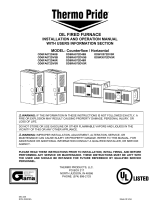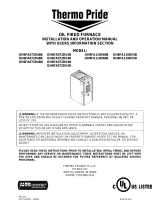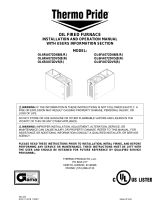
6
ii. CARBON DIOXIDE (CO
2
) OR OXYGEN (O
2
): Take a CO
2
sample from flue passageway. It is possible to
achieve readings of up to 14% CO
2
(or 2% O
2
), but it is better to have a slightly lower CO
2
(or higher O
2
)
reading with zero smoke measured. To achieve a lower CO
2
reading, open the air band, or shutter, on the
burner until zero smoke is measured.
For example, if a 13% CO
2
(or 3.5% O
2
) is recorded at a trace of smoke, open the air shutter until zero smoke is
measured with a 12% CO
2
(or 4.5% O
2
).
Adjustment of the burner to achieve a slightly lower CO
2
reading is recommended, although it slightly reduces
combustion efficiency, to keep the heating system within normal operating conditions though external conditions
may vary. Some “out-of-spec” conditions which may adversely affect burner performance are, low oil supply
temperature, dirty (contaminated) oil, low heating content (BTU/gal) oil, cold heat exchanger surfaces, and
downdraft conditions. By adjusting the burner in this manner, an operational tolerance is established allowing the
burner to function well, even under less than ideal conditions. This results in less service and maintenance during
a heating season.
iii. FLUE GAS TEMPERATURE: The flue gas temperature will vary to some extent depending on the heat input
rate, duct design, and the amount of air flow across the heat exchanger. The suggested minimum net flue gas
temperature is 350ºF, and the maximum gross flue gas temperature is 500ºF. The lower the flue gas
temperature, the higher the heating efficiency. However, stack temperatures under 350ºF may result in
condensation of water vapor in the flue gases, which in turn promotes corrosion of the heat exchanger.
iv. TEMPERATURE RISE: Temperature rise is equal to the supply air temperature minus return air temperature.
Under steady state operating conditions, the temperature rise across the heating section should be
approximately 65ºF. A higher temperature rise will slightly lower the heating efficiency. A lower temperature
rise will slightly raise efficiency, but may cause condensation.
The supply air temperature should be measured in the supply air trunkline approximately 12 inches downstream
of the supply air outlet of the appliance.
NOTICE: Minimum temperature rise is 50ºF.; maximum temperature rise is 80ºF.
k. After final adjustments are completed, tighten all screws to fix the positions of the burner air band.
l. Check for the presence of oil leaks. Correct any oil leaks found.
m. Reassemble the burner compartment cover.
n. Start and stop the unit several times while checking for proper ignition of the burner. The flame should ignite
and stabilize without any significant rumbles or pulsations.
1. Adjustment Of Heat Input Rate:
This appliance was shipped from the factory with one, fixed, main burner nozzle sized to produce the low-fire
input rate using no. 2 fuel oil at the pump pressure shown on the rating label. The input rate can be changed to
the high-fire by switching to the larger burner nozzle and increasing the pump pressure.
The main burner oil nozzles for this unit were selected based upon the following assumed characteristic values of
the fuel oil suitable for use with this appliance design:
• For no. 2 distillate fuel (domestic heating) oil having a higher heating value of 140,000 BTU per gallon and a
specific gravity of 0.88 @ 60ºF. (or “gravity” of 30º API @ 60ºF.).
It is possible to make minor adjustments to the heat input rate by adjusting the pump pressure. Sizeable
changes in input rate (especially reductions) should be made by replacing the burner nozzle. To adjust the
pump pressure to the main burner:












